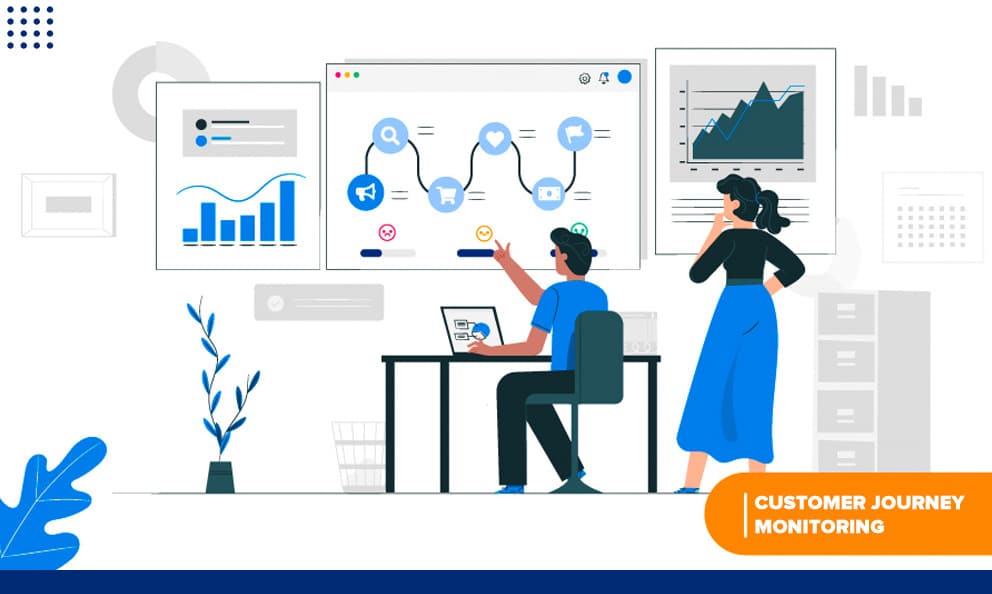 Reading Time: 4 minutes read
Reading Time: 4 minutes read
Customer journey is rarely a linear process. Organizations need resources such as time, commitment and a series of tools to monitor the customer journey successfully.
That is why in today’s article we have for you the main tools to monitor customer journey to ensure a positive experience at each point of contact between the customer and your brand.
What is Customer Journey Monitoring?
Customer Journey Monitoring (CJM) is the systematic activity of analyzing and evaluating the customer journey of a target audience. CJM looks at the consumer’s interaction with the business channels (social media, website, store, etc.), studying what touchpoints could be improved or where customers are experiencing a pain point throughout their journey with a brand.
A customer does not decide to buy an item immediately after discovering it for the first time. Typically they’ll look at a product or brand multiple times before deciding on an action, known in marketing as customer touchpoints.
Evaluating the Customer Journey Monitoring aims to gain more insight into consumer behavior, so it can be better designed, leading to an increase in conversion rate.
If you like reading about customer journey monitoring, you might find it interesting to learn about how to create a customer journey canvas
The best tools to monitor the customer journey
Using tools to monitor the customer journey, whether digital or traditional, is critical to understanding how customers interact with the brand and, more importantly, to identify the obstacles they face when engaging with a service or product.

The following are the best tools to monitor the customer journey:
1. Surveys
Surveys are one of the most important tools to monitor the customer journey. They cover various aspects of relevance to marketing, including market dynamics, growth strategies; marketing and staffing budgets, social media, and data analytics, among other topics.
When it comes to tracking the wants and needs of customers and prospects, online surveys continue to be the tool of choice for marketers, with 40% of respondents indicating they use them to engage with and learn from them.
Among the most used are the observation of clients online (26%); informal interactions with customers online (25%); offline interactions with customers (23%); and offline surveys (23%).
Other less commonly used methods include visual analysis of words and images used by online customers.
2. CRM
CRM systems can be effectively leveraged to capture customer survey responses and relevant transactional data.
For example, the results of a predictive churn model can be used by call center representatives to adjust their conversations with customers.
Those with higher estimated churn scores may be redirected to specialized customer service teams. Additionally, these customer journey monitoring tools can serve as effective repositories of marketing information.
This information can determine messaging strategy or help a sales rep better understand who they’re talking to.
Find out what is QuestionPro CX.
3. Social Networks
Another tool used to monitor the customer journey map is social networks, which allow you to configure a serious search to monitor what customers say about your brand, products, and competition. etc.
Social media is among the most used customer service channels, as it allows customer feedback to be addressed early when it is only a small problem before it becomes a major challenge.
LEARN ABOUT: Buying behavior
4. Behavior Analysis
Happy customers are the best thing that can happen to your organization, but only if they stay.
Another tool to monitor the customer journey is the analysis of consumer behavior, which consists of monitoring comments and interactions on social networks; it does not tell you so much about the behavior of customers as to where they click on your website, such as the search terms used, the impact on sales after visiting the point of sale, etc.
There are many ways to look at actual behavior, not just metrics.
If customers are searching for a specific help term, it’s a customer experience issue, so now’s the time to address it.
If you like reading about what is customer journey monitoring, you might find interesting customer journey vs customer experience: the difference.
Importance of monitoring the customer journey
Monitoring the customer journey is important because it is a strategic approach to better understanding customer expectations and is crucial to optimizing the customer experience.
Customer expectations are changing for all businesses, regardless of size: Customers are demanding an omnichannel approach to customer service, marketing, and sales.
A Customer Journey Map allows you to create personalized experiences across all touchpoints for each individual.
The tools to monitor the customer experience have great benefits, such as:
- Optimize the customer onboarding process
- Compare the desired customer experience with what they actually receive
- Understand the differences in the buyer persona as they go from potential customers to current customers through the purchase funnel
- Create a logical order for the customer journey
The days of working from a “hunch” are over. The market-related information available to sales, marketing, customer service, finance, and other departments can be staggering if you have a plan.
That plan should include the use of tools like a customer journey dashboard, along with an appreciation of the strategic value of the insights gained about the customer.
LEARN ABOUT: Customer Journey Mapping Tools
At QuestionPro CX we offer you the best tools to monitor the customer journey in your organization. Contact us! We would love to team up with you to help you achieve better customer experiences!







